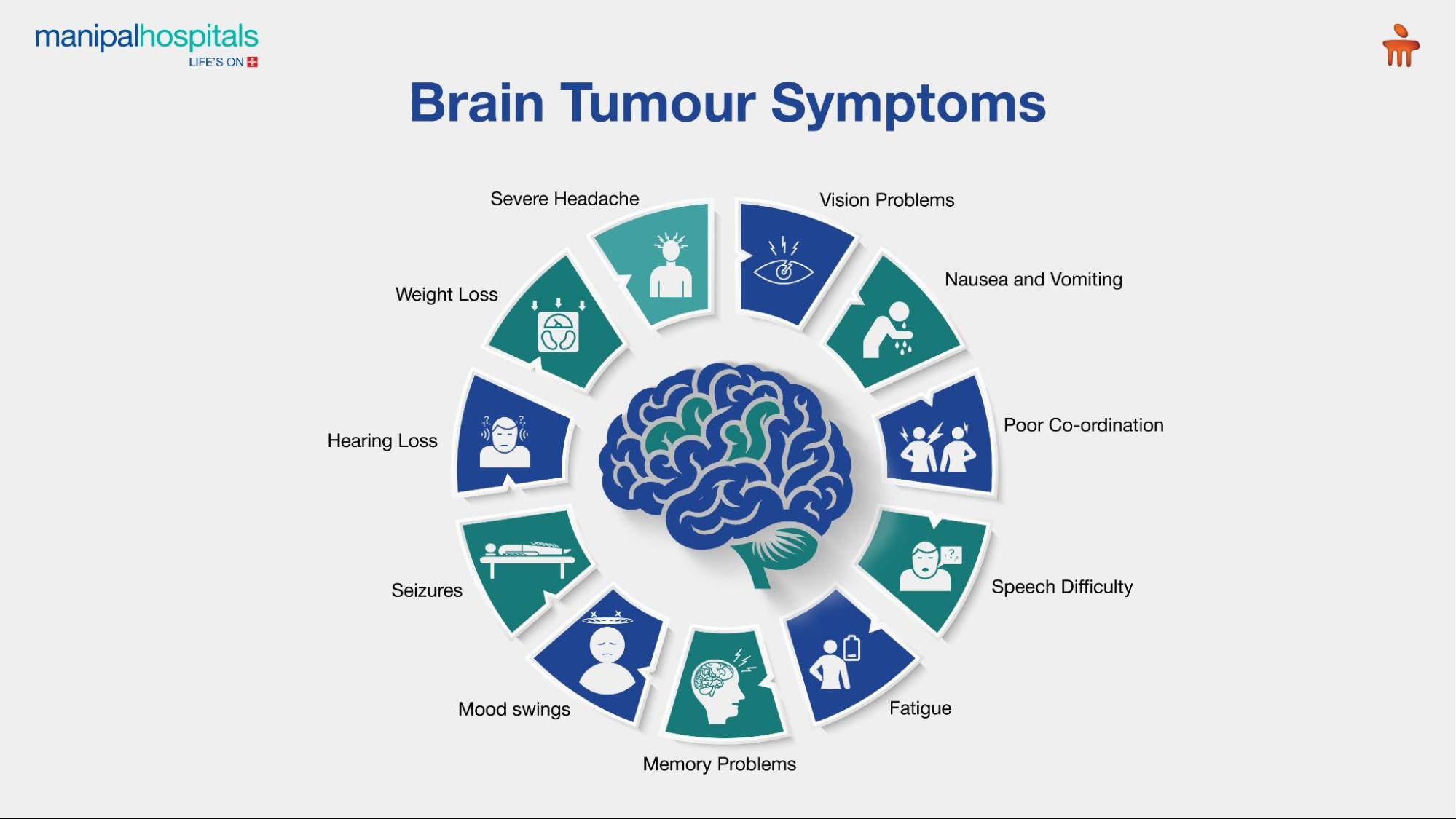Did you know brain tumours, though rare, are among the deadliest? According to GLOBOCAN 2020, brain and CNS cancers make up just 1.9% of global cancer cases but rank as the 12th leading cause of cancer-related deaths. Despite being only the 19th most common, their high fatality rate shows just how serious and life-threatening these tumours truly are.
Synopsis
A Closer Look at Brain Tumours: Do They Always Mean Cancer?
Brain tumours can either start in the brain, called primary brain tumours, or spread from cancers in other parts of the body, called secondary brain tumours.
Primary brain tumours are of different types: benign (noncancerous) and malignant. The former tend to grow slowly. If benign tumours are not detected early, symptoms develop over time and can worsen. On the other hand, malignant tumours show symptoms more abruptly and worsen quickly.
Symptoms of Brain Tumours:

-
Morning headaches that persist or worsen over time
-
Nausea or vomiting
-
Vision issues (blurred, double, or peripheral vision loss)
-
Numbness, weakness, or poor coordination
-
Speech and communication difficulties
-
Fatigue and confusion in daily tasks
-
Memory problems or trouble following directions
-
Personality changes or unusual behaviour
-
Seizures, especially if new
-
Hearing loss or dizziness
-
Unexplained weight gain or increased appetite
Understanding the Various Brain Tumour Types
Brain tumours are of many types, some of which include the following:
-
Gliomas (e.g., glioblastoma): Common malignant tumours from glial cells.
-
Choroid plexus tumours: Can be benign or malignant; often seen in children.
-
Embryonal tumours: Malignant and mostly affect infants and young children.
-
Germ cell tumours: Usually benign; common in children.
-
Pineal tumours: Pineoblastomas are malignant and often seen in kids.
-
Meningiomas: Mostly benign but can be malignant.
-
Nerve tumours: Usually benign, found on nerves like the one connecting the ear and brain.
-
Pituitary tumours: Grow near the pituitary gland.
-
Others: Rare tumours can also develop in and around the brain.
Brain Tumour Treatment
The treatment approach for a brain tumour depends on several factors, including whether the tumour is benign or malignant. Additional considerations include the tumour’s type, size, grade, location, overall health, and personal preferences.
Common treatment options may include:
-
Surgery
-
Radiation therapy
-
Radiosurgery
-
Targeted drug therapy
Brain Tumour Surgery - What and When to Consider
The primary goal of brain tumour surgery is to remove as much of the tumour as safely as possible. Complete removal isn't always achievable, especially when tumours are near critical brain areas. Surgery is usually the first-line treatment, but eligibility depends on tumour type, grade, location, DNA mutations, and overall patient health.
Sometimes, removing part of a brain tumour can ease symptoms by reducing pressure on the brain. If the tumour isn’t near areas that control important functions like speech, it can be completely removed. But when it’s close, only part of the tumour is removed to avoid risks. Surgery may also be done to get a tissue sample for diagnosis (Biopsy) or as palliative care to improve quality of life and help other treatments, like radiation therapy, to work effectively.
What are the types of Brain Tumour Surgeries?
There are usually two main types of Brain Tumour Surgery - Craniotomy and Neuroendoscopy
-
Craniotomy: A part of the skull is removed under general anaesthesia to access and remove the tumour. Pre-surgery brain scans help guide the procedure. Surgeons use tools like microscopes, scalpels, and ultrasound to remove the tumour while protecting healthy tissue.
-
Awake Craniotomy: When a tumour is near critical brain areas like those for speech or movement, an awake craniotomy may be done. Patients are awake during surgery to perform tasks while the tumour is removed. General anaesthesia is used at the start and end, but is reduced during the main part to keep the patient awake.
-
Neuroendoscopy: A minimally invasive surgery using an endoscope inserted through a small skull opening to remove tumours, especially in fluid-filled areas or the pituitary gland. It is often used for hydrocephalus or pituitary tumour removal.
Other types of Brain Tumour Surgeries include:
-
Surgery for Chemotherapy Delivery: Involves removing the tumour and placing chemotherapy wafers in the cavity to slowly kill remaining cancer cells. A ventricular access device (e.g., Ommaya reservoir) may also be used to deliver drugs directly.
-
MRI-Guided Laser Ablation: A minimally invasive method that uses laser heat to destroy hard-to-reach or aggressive tumours like glioblastomas, guided precisely by MRI imaging.
Conclusion
Several brain tumour advancements are being made, with doctors using newer, less invasive techniques like endoscopic endonasal surgery, Laser Therapy (LITT), and awake craniotomy. The role of AI in improving the effectiveness and safety of brain tumour surgeries is also being researched. If you or your loved ones are diagnosed with a brain tumour and are seeking a second opinion for brain treatment – surgical or non-surgical – consult our expert neurologists at Manipal Hospitals, Broadway.
FAQ's
Brain tumours, whether benign or malignant, can be cured. However, chances of recovery depend on factors like tumour grade, size, type, location, and overall health. Benign tumours can be cured 90-100%. On the other hand, malignant ones require ongoing management to control growth.
Watch out for signs like persistent headaches, blurred vision, seizures, problems with balance and coordination, weakness, etc. If you notice one or more symptoms, especially if they are new and worsening, it is important to consult a neurologist. They will recommend tests to rule out a brain tumour.
Neurologists start by discussing your symptoms, lifestyle, and medical history. They then do simple tests to check your vision, hearing, balance, and reflexes to see which part of the brain may be affected. If a tumour is suspected, you may be asked to get a brain scan, like an MRI or CT. In some cases, further tests like a spinal tap, biopsy, or tumour marker test may be needed to confirm the diagnosis and understand the tumour better.
Post-surgery, swelling goes down, and damaged areas begin to repair. With the Neuroplasticity process, new connections are formed between brain cells to help regain function. Rehabilitation helps to support the patient's recovery process.
You can schedule an appointment at the Neurology Department of Manipal Hospitals, Broadway, by contacting us or visiting our website.






















 6 Min Read
6 Min Read












